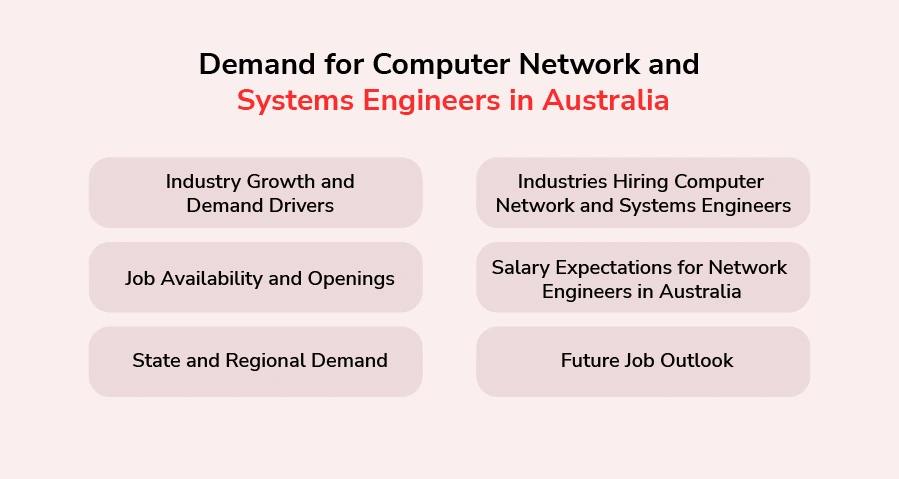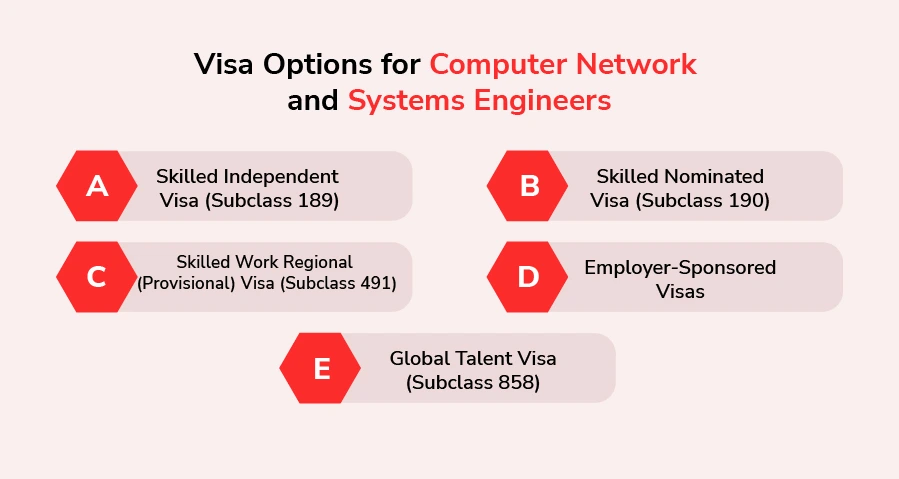
Skilled professionals choose Australia as their prime migrant destination because it offers promising career prospects and an exceptional lifestyle. The Australian job market actively seeks computer network and systems engineers, and these professionals are eligible for permanent residency (PR) visas.
This blog post contains a complete guide that explains all aspects of immigration for computer network and systems engineers who want to live in Australia, including eligibility requirements, possible visas, skill assessments, employment opportunities, and steps to permanent residency.
🔑 Key Highlights
- Computer Network and Systems Engineers appear on Australia’s MLTSSL which enables their qualified migration through the skilled program.
- Australian Network Engineers have access to apply for five different visa options which include Subclass 189, 190, 491, 482, and 186.
- Network Engineers seeking Australian Computer Society (ACS) approval through their skills assessment must obtain a positive outcome.
- The field of network engineering provides excellent career prospects because its practitioners receive high salaries and their fields experience strong job market growth especially in cloud computing and 5G along with cybersecurity domains.
Who is a computer network and systems engineer? 💭🤔
A computer network and systems engineer implements and supervises network infrastructure with IT administration duties at the organisation level.
Their role includes:
- Configuring and maintaining network hardware/software
- Monitoring and optimising system performance
- Staff members must establish and implement security protocols for the network.
- Troubleshooting network and system issues
- Providing technical support to users
Professional network and system engineers hold the ANZSCO Code 263111, and this occupation is on the Medium and Long-Term Strategic Skills List (MLTSSL), which enables them to pursue permanent residency in Australia.
Demand for Computer Network and Systems Engineers in Australia

The digital economy of Australia continues to expand as organisations from the public and commercial sectors, along with different industries, depend more on computer networks, cloud services and cybersecurity systems.
A transition in IT infrastructure standards leads organisations to demand technical professionals who specialise in the computer network and engineering field for infrastructure security management functions.
1. Industry Growth and Demand Drivers
Various elements stimulate the rising need for computer network and systems engineers across Australia.
The move towards cloud-based solutions by businesses requires a strong network infrastructure.
Organisations need computer network and systems engineers to handle cybersecurity risks that continue to grow.
Companies invest money in network infrastructure with remote access capabilities throughout the cloud, which further increases the need for network engineering professionals.
5G advances and telecommunications system development created multiple employment choices throughout the market.
The Australian national government invests in IT projects like smart cities and digital infrastructure development that grow the professional need for information technology experts.
2. Industries Hiring Computer Network and Systems Engineers
The Australian job market includes multiple industries that need network engineers to oversee their information technology infrastructure.
The telecommunications sector requires network engineers to manage and develop their telecommunication network infrastructure at Telstra Optus along with Vodafone.
Commonwealth Bank, ANZ and NAB from the banking sector and financial institutions seek IT specialists who ensure safe financial operations and defend data as organisational assets.
The growing popularity of cloud solutions such as AWS, Microsoft Azure and Google institutions requires technicians who will manage these cloud platforms and data centres.
Healthcare institutions, with government agencies, need powerful IT systems to run their day-to-day operations, maintain digital records and protect their networks from cyber threats.
Network engineers work for cybersecurity businesses to watch over digital infrastructure and safeguard assets by protecting them against cyber threats.
3. Job Availability and Openings
The Australian job market shows regular posts seeking computer network and systems engineers. The employment market in Sydney Melbourne Brisbane and Perth showed approximately thousands of open IT positions as of 2025.
4. Salary Expectations for Network Engineers in Australia
The Australian market offers competitive earnings to computer network and systems engineers who can expect increasing payment prospects through performance and field concentration.
5. State and Regional Demand
The Australian job market shows a high need for network engineers, particularly because certain states prioritise IT professionals for their Subclass 190 & 491 Permanent Residence visas through state nominations.
- New South Wales (Sydney): The financial and tech hub, with high demand in banking, fintech, and cloud services.
- Majorities of IT jobs exist in Victoria, including cybersecurity job openings and business enterprise IT services positions.
- Queensland (Brisbane, Gold Coast) experiences an increasing need for people who work in cloud computing cybersecurity and telecom sectors.
- South Australia (Adelaide): Emerging as a cybersecurity hub with strong government support.
- IT solutions play a vital role in supporting building and mining operations throughout Perth in Western Australia.
6. Future Job Outlook
Australian job demand for computer network and systems engineers shows a consistent trend of growth during the next decade because of these reasons:
- Increasing reliance on IT infrastructure
- AI, along with cloud computing, continues towards expansive growth.
- Need for stronger cybersecurity measures
- Adoption of 5G and IoT technologies
Visa Options for Computer Network and Systems Engineers

Several choices of immigration visas exist for computer network and systems engineers who want to reside in Australia.
A. Skilled Independent Visa (Subclass 189)
- Points-tested permanent visa
- No employer sponsorship required
- The Department of Home Affairs must invite candidates to use this visa.
- The visa enables both visa holders and family members to settle anywhere in Australia for work or residence purposes.
B. Skilled Nominated Visa (Subclass 190)
- The visa-issuing authority requires receipt of the nomination from a state or territory of Australia.
- Applicants must meet state-specific requirements
- Provides permanent residency upon approval
C. Skilled Work Regional (Provisional) Visa (Subclass 491)
The visa becomes available through being nominated from a regional area or through family sponsor arrangements.
Offers a pathway to permanent residency after three years
D. Employer-Sponsored Visas
1. Temporary Skill Shortage Visa (Subclass 482)
Requires employer sponsorship
Applicants who obtain sponsorship from their employer can transition to PR status through the Employer Nomination Scheme (ENS) Subclass 186.
2. Employer Nomination Scheme Visa (Subclass 186)
Direct PR visa requiring employer sponsorship
Suitable for those working in Australia on a TSS visa
E. Global Talent Visa (Subclass 858)
For exceptionally skilled professionals with expertise in:
- Cybersecurity
- Artificial Intelligence
- Cloud Computing
Skills Assessment for Computer Network and Systems Engineers
The Australian Computer Society (ACS) needs to assess Computer Network and Systems Engineers before they can apply for a PR visa to Australia. As part of the assessment process performed by the Australian Computer Society, they determine if job qualifications and work background match Australian professional standards.
A positive skills assessment stands as a mandatory requirement for applicants who want to submit an Expression of Interest (EOI) for a skilled visa in the PR visa process.
1. ACS Skills Assessment Process
The Australian Computer Society leads the ACS skills assessment through this step-by-step procedure.
Step 1: Check Eligibility
To qualify, applicants must have:
The applicant needs to hold a bachelor’s degree or a higher qualification in IT, computer science, network Engineering or a similar academic field.
The candidate should show experience in working with computer networks IT infrastructure or systems engineering.
Additional work experience becomes mandatory when the applicant holds a degree that is different from information technology subjects.
Individuals who lack college diplomas may use the Recognition of Prior Learning (RPL) process to become eligible for assessment.
The second step of candidate selection requires applicants to pick between available assessment paths.
Step 2: Choose the Right Assessment Pathway
ACS presents assessment routes that match the professional qualifications and job history of each applicant into four different pathways.
a. ICT Major—Australian or Overseas Degree
Applicants who possess ICT degrees, including computer science, along with IT and network engineering qualifications.
At least two years of relevant work experience (in the last 10 years)
b. ICT Minor—Australian or Overseas Degree
Applicants with a degree in a related field but not a full ICT qualification
At least five years of relevant work experience
c. Non-ICT Degree Holders
The application process accepts candidates from various fields who hold a degree outside the Information Technology area, such as business or mechanical engineering, and above.
At least six years of relevant work experience.
d. Recognition of Prior Learning (RPL) Pathway
- Applicants without formal IT qualifications
- The applicant needs at least eight years of professional experience to qualify.
- Candidates need to present an RPL assessment showing their competency in ICT.
How do you apply for an Australian PR visa?

The process of obtaining an Australian Permanent Residency (PR) visa becomes essential for Computer Network and Systems Engineers (ANZSCO 263111) who wish to migrate to Australia.
The following step-by-step guide shows the way to successfully obtain an Australian PR visa.
Step 1: Check Your Eligibility
Initiate the visa application process only when you verify that all minimal requirements are fulfilled.
- Your job as a Computer Network and Systems Engineer exists on the Medium and Long-Term Strategic Skills List (MLTSSL).
- The requirements for this visa include holding either a bachelor’s degree or a higher qualification.
- Your experience includes work in computer networking together with IT infrastructure and systems engineering.
- You hold suitable English capabilities, which can be proven through TOEFL/PTE/IELTS results.
- The requirements about health and character stand as one of the necessary conditions for your application.
- The visa application starts when you achieve all the required qualifications.
Step 2: Get your skills assessed by ACS
The Australian Computer Society assesses to verify that your credentials and professional experience meet Australian professional standards. A positive result from the skills assessment procedure shall serve as a requirement for applying for a permanent residency visa.
Steps to Get an ACS Skills Assessment:
1. Make sure your degree and work experience satisfy the requirements stated in ANZSCO 263111 according to the Australian Computer Society (ACS).
2. Gather required documents
You need:
- Passport and identity documents
- Academic transcripts and degree certificates
- Work experience reference letters
Performance of employment will be verified through bank statements and tax documents in addition to paying payslips.
3. Apply online at the ACS website
4. Pay the assessment fee (~AUD 500-600)
5. Wait for the assessment result (8-12 weeks)
Step 3: Calculate your Points for PR
The Australian General Skilled Migration (GSM) programme employs a points system through which aspiring PR candidates need to accumulate at least 65 points for eligibility.
You must retake the English test to gain a better test score.
Prospective migrants need to submit state nominations through either Subclass 190 or 491.
Studying in regional Australia
Candidates who reach 65 points can submit their Expression of Interest (EOI).
Step 4: Submit an Expression of Interest (EOI) in SkillSelect
A prospective visa applicant should not mistake the EOI for a visa application because it serves only to demonstrate an interest in Australian migration. The Australian government selects suitable candidates for permanent residency approval by using SkillSelect to invite the highest-ranking applicants to apply.
Steps to Submit EOI:
1. Create an account on the SkillSelect portal
2. Fill in details about:
- Personal information
- Work experience and education
- English test results
- ACS skills assessment reference number
- People who apply for Subclass 190 or 491 must indicate their state nomination choices.
3. Submit the EOI online
4. Wait for an Invitation to Apply (ITA)
Step 5: Receive an Invitation to Apply (ITA)
Applicants must wait until the Australian government invites them to apply for their PR visa after submitting their EOI. Invitations are issued based on:
The points ranking system enables the Australian government to invite applicants who score higher points first.
Certain professions have maximum yearly admission numbers established by the programme.
Candidates who gain state/territory nominations receive their application invitations sooner when compared to other candidates.
The last step in the process includes submitting your PR visa application through online channels at ImmiAccount.
Conclusion
Migrating to Australia as a Computer Network and Systems Engineer (ANZSCO 263111) pathway provides professionals with an excellent combination of professional progress along with competitive earnings and Australian residency privileges. The migration process for computer network and systems engineers demands meticulous preparation together with precise documentation and targeted approaches that fulfil visa and skills assessment demands.
The steps described in this guideline help you handle difficulties, including intense competition, rigorous ACS evaluation standards and long visa evaluation durations. Your Invitation to Apply (ITA) for Australian permanent residency becomes stronger when you submit a well-developed skills assessment application and achieve high English test results together with enough PR points.
Migrating to Australia becomes smoother when you already have a job positioned either before or after your move since this boosts your employment possibilities and establishes financial security. Using industry certifications along with networking opportunities with Australian recruiters and submitting applications for employer-sponsored visas will simplify your job search activities.
FAQs
1. What does a computer networking engineer do?
A computer networking engineer designs, implements, maintains, and troubleshoots network systems to ensure seamless communication between devices and systems.
2. What is the role of a system and network engineer?
- The implementation of network infrastructure includes designing along with the configuration of LAN, WAN and VPN systems.
- You must establish and direct networking hardware as well as the software it runs.
- Monitoring network performance and troubleshooting issues.
- Organisations should establish firewalls together with encryption procedures to improve cybersecurity safety.
- The company plans to replace outdated systems with more efficient and secure versions.
3. Is a system engineer an IT job?
Yes, a system engineer is an IT job. They design, implement, and maintain IT systems, ensuring hardware and software work together efficiently and securely.
4. What is the best course for a network engineer?
A network engineer should pursue these particular courses:
Beginner: CompTIA Network+, Cisco CCNA
Intermediate: Cisco CCNP, Juniper JNCIA/JNCIS
Advanced: CCIE, AWS/Azure Networking, CISSP (Security)
5. Is networking engineering a good career?
Yes, With increasing demand for secure and high-performing networks, networking engineers are in high demand, offering job stability and excellent career growth opportunities.
